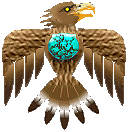The Native American Pow Wow
Originally powwows meant medicine men. Later it came to mean a special gathering place (like river or hills, etc.) where Native Americans would celebrate, establish alliances, and hold healing rituals. Today Powwows are a time to renew ties with family and friends and to celebrate. A powwow begins with a prayer from the host tribe's medicine man. The powwow can last hours or several days. It consists of dancing, drumming and chants, which in many cases are prayers to the spirit world. There is a great deal of information and terms that would be helpful to know before you go to your first powwow. To truly start to understand the regalia you are seeing, the dance steps and the music, as well as the sacredness of the powwow, a little time and effort on your part researching would enhance your enjoyment of what you are going to be witnessing.
Below are a few terms. In your research you will find many more terms and definitions. I have selected just a few.

A few personal memories...I went to my first powwow when I was about 7 years old. I was so excited that I could not wait to get to the powwow. But my father had a few ideas of his own as to what needed to be done before we could attend. (It was a whole neighborhood trip.) Dad took us to the library and with the help of the librarian we checked out books on the life style and culture of the Native American. (Back then we were still saying Indian.) Each one of us learned something that we shared with the other one. It helped the week go by before our first powwow. But more than that we felt challenged by the knowledge the other ones had learned. It became "I want to tell you what I know" type of week. Then the night before the powwow my Father came home from work and said he wanted to see all of us after dinner on the front porch. Now, we were expecting to get information on the time we were going and how long we were going to stay and if we were going to need money. But my Father had a different idea for that front porch meeting. We were told "in no uncertain terms" that this was a sacred ceremony we were attending. He expected us to behave as if we were in our own church. This outdoor ceremony was just that sacred. Since in church we were expected to enter quietly and sit in the pew and listen and learn, that is exactly what he expected from us. We better not get up and run around or talk or be noisy. We were to find our seats and wait patiently. He also added that anyone who didn't show the proper respect would be taken out of the area and their parents would be called to come get them. I was sure I knew what it was going to be like but I was so very wrong. Dad didn't really have to tell us to sit and be quiet though. We were so awstruck by the entire event we witnessed that none of us even got "the look" from Dad. We were allowed to go over and ask questions of a wonderful man who took time for us. I am sure we said the wrong things. But it was out of lack of knowledge not out of lack of respect. I bought my first ring there at one of the tables. I still have it to this day tucked away with fond memories. This started my love of this culture and the ways of the Native American people. They were kind enough to a group of children and took the time for them and treated them with the respect of a child wanting to learn more. It has been a life long learning experience that has given me much joy. Yet, I know so little in the big picture of the Native American. There is always more to know and understand. Along the way I have met some very kind and loving people who still take the time for that "little girl" in me who wants to know more. They have enriched my life. I pray that I have in some small way done the same for them. I am honored to call them friends.
Blessings,
Just a few comments on the etiquitte of attending a powwow
I know you will enjoy yourself and learn so much. May you have as great a time as I did at my first powwow.
Native American graphics by |